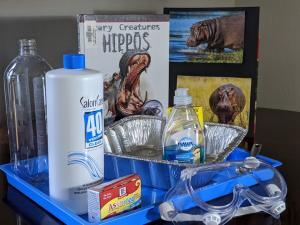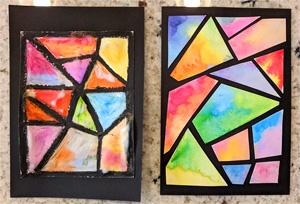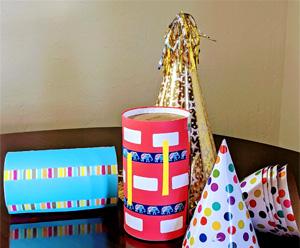Categories
SUPPLIES AND INGREDIENTS:
- ½ cup 49 Volume Hydrogen Peroxide (*3% solution, first aid quality, will work … it produces a smaller reaction)
- 1 TBSP liquid dish soap
- 1 packet (1 TBSP) Active Dry Yeast
- 4 TBSP warm water
- Plastic Cup for mixing yeast and water
- Food coloring
- Plastic soda bottle (*16 oz. - 1 liter)
- Washable or protected work surface
- Foil Tray with high sides and/or Larger cookie sheet or tray with sides
- Funnel (optional)
- *Safety goggles (*or … ski/snow goggles, swim goggles) … for general eye protection!
DIRECTIONS:
To make up a batch of hippopotamus toothpaste …
- Place the soda bottle in your tray(s) … on a washable, protected surface.
- Pour 150 ml (½ cup) of 40 Volume Hydrogen Peroxide into the soda bottle.
- Add 1 tablespoon of liquid dishwashing soap to the bottle.
- Pour the packet of yeast into the small cup.
- Pour 4 tablespoons of warm water over the yeast.
- Carefully swirl the cup around to further mix the yeast and water. *It should be the consistency of melted ice cream. Allow about 30 seconds. Add a bit more warm water, if needed.
- Dribble several stripes of food coloring down the inside of the soda bottle. This should produce stripes, just like you might see in real toothpaste.
- Pour the yeast solution into the soda bottle … and stand back! Watch the mixture expand and foam up.
(You might want to use a funnel for this!)
*Once the chemical reaction is complete, you should have (mostly) just soapy water and yeast. However, if you used the Volume 40 product, and some of the peroxide was unreached in the experiment, it could irritate skin and eyes. For that reason, it’s
recommended that you don’t play with the foam! And DON’T BRUSH ANY TEETH WITH THIS FOAM!
How It Works …
Each tiny foam bubble in this chemical reaction is filled with oxygen. The yeast is a catalyst, a substance that speeds up a reaction. It quickly broke apart the oxygen from the hydrogen peroxide … and that created lots and lots of bubbles! Your experiment not only created bubbles, but also heat … that makes it an EXOTHERMIC reaction.
Clean Up …
It’s safe to use a sponge to wipe up foam from your table surface, and just wash the remaining liquid and foam from the bottle and tray down the sink drain.
Watch this project at: https://youtu.be/N91i9ih62ZM?list=PLMEg2Dd0dSFctLfDQxsL5SmuE8zkwQFmu
Supplies:
- Watercolors
- Cup of water
- Paint brush
- Pencil
- Black crayon or oil pastel
- White watercolor paper or heavy cardstock
- Black cardstock or construction paper
- White school glue
- Glue stick
- Optional: popsicle stick or toothpicks to spread glue
Directions:
Oil Pastel & Glue Watercolor Stained Glass
- Lightly draw a stained-glass design with pencil on your white paper.
- Outline the stained-glass design with black pastel or crayon.
- Working section by section, wet a section of your design with a paintbrush and plain water. Dab watercolor in that section. Feel free to mix colors.
- Repeat for each section of your design, wetting the paper first, before adding paint.
- Let your design dry.
- Outline each section of your design with glue, inside the black lines.
- Spread glue in each section.
- Let your project dry.
- Finished!
Collage-style Stained Glass
- You will need a sheet of black cardstock or construction paper to be the background of your final project.
- Lightly draw a stained-glass design with pencil on your white watercolor paper.
- Working section by section, wet a section of your design with a paintbrush and plain water. Dab watercolor in that section. Feel free to mix colors.
- Repeat for each section of your design, wetting the paper first, before adding paint.
- Let your design dry.
- Cut out each section of your design.
- Lay out your cutout pieces on the black paper.
- Once you like the arrangement, glue down each piece to the black paper with a glue stick.
- Finished!
Watch this project at: https://www.youtube.com/watch?v=vu2UYBh1G3w&list=PLxg4vmuqrAtckvp9eurSG…
SUPPLIES:
- Coffee or Oats Can (empty)
- Thick Rubber Bands
- Medium / Large Hex Nut
- Paper Clips (Large and Small)
- Nail / Hammer
- Screwdriver
- Tape
- Pencil (*optional)
- Colored paper, tape, and stickers for decoration (*optional)
DIRECTIONS:
- Poke a hole in the center of the coffee / oats can top and bottom using a hammer and nail.
- Enlarge the hole by tapping a screwdriver through the hole with a hammer.
- Tape your rubber band to the top of the large nut. Make sure it’s centered and very secure! (*Depending on the size of your can, you may need to knot two bands together so that there’s not too much tension on them.)
- Open up a small paper clip and thread it through one loop of the rubber band. This will be your “needle.”
- From the inside of the can, very carefully “thread” the paper clip (with the rubber band attached) through the hole in the bottom of the can. There may be sharp edges, so be careful! Slip a large paper clip through the rubber band loop to secure it in place. Remove the paper clip “needle.”
- Place the paper clip “needle” through the remaining loop of the rubber band and carefully pull it through the hole in the coffee / oats can lid. (If the hex nut has moved closer to one side of the rubber band, move it back so that it hangs on the center of the can when stretched.) (*If necessary, place the pencil between the lid and can to temporarily hold everything in place.)
- Slip another large paper clip through the rubber band loop to secure it in place. Remove the paper clip “needle” and the pencil. Make sure the lid is attached securely to the can!
- If you’d like, decorate your can with colored paper, tape, and stickers. Time for testing! On a flat, smooth surface, gently roll your can away from you. Just before it mysteriously begins to roll back, summon your super powers and call the can back to you. A little “hocus pocus” or “abracadabra” will convince your audience of the magic.
*Troubleshooting : Be sure to use thick rubber bands that will store up enough energy to cause the can to roll back to you. Also check that your hex nut is not touching the side of the can. If it is, use a shorter rubber band or knot your rubber band. If just one band is too short and tight, knot two rubber bands together. You can also thread an extra hex nut onto the outside top and bottom of the can as spacers if your rubber band(s) are too long. Experiment and you’ll get it just right.
Watch this project at: https://youtu.be/Hk1OthEqSfs



 Ruth Holley Library will be temporarily closed for approximately one week starting Mon., Dec. 2 to complete roof repairs.
Ruth Holley Library will be temporarily closed for approximately one week starting Mon., Dec. 2 to complete roof repairs.

